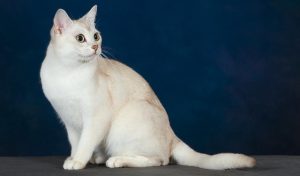The Enigmatic Burmilla: A Tale of Elegance and Charm
A Serendipitous Beginning: The Origin and History of the Burmilla Cat
 The enchanting story of the Burmilla began in the United Kingdom in 1981. This breed emerged by a happy accident when Baroness Miranda von Kirchberg’s male Chinchilla Persian named Jemari Sanquist and her lilac Burmese female named Bambino Lilac Fabergé met unexpectedly. The result was a litter of kittens with a unique appearance, combining the elegant, shaded silver coat of the Chinchilla Persian with the sleek, muscular build of the Burmese. These kittens were so striking that a new breed was established and named “Burmilla,” a portmanteau of Burm-ese and Chinch-illa. Official recognition by the Governing Council of the Cat Fancy (GCCF) followed in 1989.
The enchanting story of the Burmilla began in the United Kingdom in 1981. This breed emerged by a happy accident when Baroness Miranda von Kirchberg’s male Chinchilla Persian named Jemari Sanquist and her lilac Burmese female named Bambino Lilac Fabergé met unexpectedly. The result was a litter of kittens with a unique appearance, combining the elegant, shaded silver coat of the Chinchilla Persian with the sleek, muscular build of the Burmese. These kittens were so striking that a new breed was established and named “Burmilla,” a portmanteau of Burm-ese and Chinch-illa. Official recognition by the Governing Council of the Cat Fancy (GCCF) followed in 1989.
Recognition and Varieties: Acknowledgement Across Cat Fancies
Within the GCCF (Governing Council of the Cat Fancy), the Burmilla is recognized as part of the Asian group. The breed is also acknowledged by the Fédération Internationale Féline (FIFe) as the Burmilla. The silver shaded and tipped variations are recognized by GCCF, FIFe, CCCA, ACF, and CFA. Since late 2011, FIFe has also included golden shaded and tipped Burmillas in its registry, and these varieties are recognized by the ACF as well.
The Burmilla is available in two coat lengths: shorthair and semi-longhair. In the GCCF, the semi-longhair Burmilla is referred to as the Tiffanie. In Australia, the Australian Tiffanie is a distinct breed development and should not be confused with the Burmilla or the GCCF’s Tiffanie and the North-American Chantilly-Tiffany.
Shades of Elegance: Types of the Burmilla Breed
The Burmilla breed, while relatively uniform in its standards, comes in a variety of coat patterns and colors, adding to its allure. The primary distinctions within the breed are based on the coat’s shading and coloring:
Shaded Burmilla
The shaded Burmilla has a base color with a lighter undercoat, and the tips of the hair are shaded, creating a subtle, elegant gradient effect.
Tipped Burmilla
The tipped Burmilla features a lighter overall appearance with just the tips of the hair colored, resulting in a delicate and shimmering look.
A Portrait of Grace: Physical Appearance of the Burmilla
The Burmilla is a medium-sized cat with a well-balanced, muscular body, typically weighing between 8 to 12 pounds. Their head is slightly rounded with a gentle slope to the nose, and their expressive eyes range from green to yellow. The ears are medium-sized, set well apart, and slightly rounded at the tips.
The most striking feature of the Burmilla is its luxurious, short, dense, and silky coat, which comes in a variety of colors. Common colors include black, blue, brown, chocolate, and lilac. Additionally, red, cream, and tortoiseshell (calico) varieties have been bred, although these colors are not recognized by the Cat Control Council of Australia (CCCA). The Burmilla also inherits its color ranges from two breeds, including the entire Burmese spectrum of colors: black (including brown or sepia black), blue, chocolate, lilac, and all the O gene range, both in Burmese Expression (sepia colored) and Full Expression (solid/self colored).
Gentle Spirits: The Personality and Habits of the Burmilla
Burmilla cats are known for their gentle and affectionate nature. They are social animals that thrive on human interaction and form strong bonds with their families. These cats are playful and curious but tend to be less demanding than some other breeds, making them ideal companions for both active and more relaxed households.
In comparison to other breeds, Burmillas are more interactive than Persians but not as vocal as Siamese. They enjoy interactive play and mental stimulation, making puzzle toys and feather wands some of their favorites.
Timeless Companions: The Lifespan of the Burmilla
Burmilla cats are generally healthy and have a lifespan ranging from 12 to 15 years, with some living even longer with proper care. Regular veterinary check-ups, a balanced diet, and a stimulating environment contribute to their longevity and well-being.
Fascinating Tidbits: Interesting Facts About the Burmilla
- Accidental Origins: The Burmilla’s creation was entirely accidental, resulting from an unexpected mating between a Chinchilla Persian and a Burmese.
- Distinctive Eyes: Their large, expressive eyes, ranging from green to yellow, are one of their most captivating features.
- Social and Adaptable: Burmillas are known for their adaptability, making them excellent pets for various household types, from single individuals to large families.
- Low Maintenance Coat: Despite their luxurious appearance, Burmillas require minimal grooming due to their short, dense coat.
- Recognized Beauty: The breed’s unique beauty and temperament have earned it recognition and popularity in cat shows worldwide.
The Burmilla cat, with its elegant appearance, gentle personality, and fascinating history, continues to enchant cat lovers around the globe. Whether you’re drawn to their shimmering coats or their affectionate companionship, the Burmilla cat is a breed that brings both beauty and joy to any home.
Leave a Reply